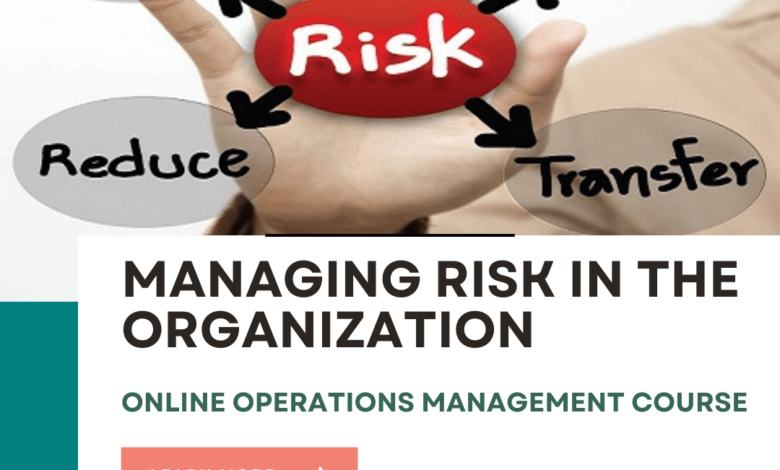
Is Your Organisation At Risk?
Is your organisation at risk? That’s a question every leader should be asking themselves, constantly. From sneaky internal threats to the ever-evolving landscape of cybercrime, the potential for disruption is real and ever-present. This post dives deep into identifying vulnerabilities, developing mitigation strategies, and building resilience to safeguard your business against the unexpected.
We’ll explore common internal threats like employee negligence and malicious insiders, alongside external pressures such as evolving regulations and the ever-increasing sophistication of cyberattacks. We’ll even look at how emerging technologies, while offering incredible opportunities, can also introduce new and unforeseen risks. Think of it as a comprehensive security checkup for your organisation, helping you identify weaknesses before they become major problems.
Identifying Potential Risks
Understanding the threats to your organization’s security and stability is crucial for effective risk management. A proactive approach, identifying potential vulnerabilities before they are exploited, is far more effective than reacting to crises. This involves examining both internal weaknesses and external pressures, as well as considering the impact of rapidly evolving technologies.
Common Internal Threats to Organizational Security
Internal threats often stem from human error or malicious intent within the organization itself. These can significantly impact data security, operational efficiency, and overall reputation. Negligence, such as failing to update software or implement strong passwords, can create vulnerabilities exploited by external actors. Malicious insiders, motivated by financial gain, revenge, or ideological reasons, pose a more direct and insidious threat.
They might steal sensitive data, sabotage systems, or leak confidential information. Effective internal controls, employee training, and robust security protocols are vital to mitigate these risks.
External Factors Compromising Organizational Stability
External factors beyond the organization’s direct control can also pose significant threats. These include natural disasters (earthquakes, floods, hurricanes), which can disrupt operations and damage infrastructure. Economic downturns can reduce demand for products or services, leading to financial instability. Political instability, regulatory changes, and intense competition in the marketplace all contribute to a complex risk landscape. Cyberattacks, originating from external sources, are a particularly significant threat, targeting sensitive data, disrupting operations, and potentially causing reputational damage.
Maintaining business continuity plans and diversifying operations can help mitigate these external risks.
Impact of Emerging Technologies on Organizational Risk Profiles
The rapid advancement of technology introduces both opportunities and risks. Artificial intelligence (AI), while offering potential benefits, also presents challenges related to algorithmic bias, data privacy, and job displacement. The increasing reliance on cloud computing introduces vulnerabilities related to data security and vendor lock-in. The Internet of Things (IoT) expands the attack surface, with numerous connected devices potentially becoming entry points for malicious actors.
Organizations need to adapt their security strategies to address these emerging threats, staying ahead of the curve through continuous monitoring and adaptation. For example, the widespread adoption of AI in financial institutions requires robust security protocols to prevent fraudulent activities enabled by sophisticated AI-driven attacks.
Risk Levels of Different Organizational Structures
The risk profile of an organization is influenced by its structure. Large, complex organizations often face greater risks due to their size and the complexity of their operations. They have more potential points of failure and a larger attack surface. Smaller, more agile organizations might be more vulnerable to specific threats due to limited resources and less robust security infrastructure.
Decentralized organizations, while offering flexibility, may struggle with maintaining consistent security standards across different units. Conversely, highly centralized organizations might face greater risk from a single point of failure. The optimal structure depends on the specific industry, size, and risk tolerance of the organization. A well-defined risk management framework is essential regardless of the organizational structure.
Is your organization at risk of falling behind the competition? Outdated systems can cripple efficiency and leave you vulnerable. Modernizing your applications is key, and that’s where exploring options like domino app dev, the low-code and pro-code future , becomes crucial. Investing in the right development strategy can significantly reduce your risk and boost your competitive edge.
Ultimately, the question remains: is your organization prepared for what’s next?
Hypothetical Scenario Illustrating Significant Organizational Risk
Imagine a large multinational corporation reliant on a centralized cloud-based system for all its operations. A sophisticated ransomware attack targets this system, encrypting critical data and disrupting operations globally. The attackers demand a substantial ransom for the decryption key. The company faces significant financial losses due to downtime, potential data breaches leading to legal and reputational damage, and the cost of recovery and remediation.
This scenario highlights the interconnectedness of modern organizations and the catastrophic consequences of a single major security failure. The impact extends beyond financial losses to include damage to brand reputation, loss of customer trust, and potential legal repercussions. A robust cybersecurity strategy, including regular backups, incident response plans, and strong security protocols, is crucial to mitigate such risks.
Assessing Current Vulnerabilities: Is Your Organisation At Risk
Understanding your organization’s vulnerabilities is crucial for effective risk management. This involves a thorough examination of your systems, processes, and people to identify weaknesses that could be exploited by malicious actors or lead to accidental data breaches. A proactive approach to vulnerability assessment is far more cost-effective than reacting to a breach after it occurs.
Examples of Vulnerabilities Leading to Data Breaches
Several common vulnerabilities can lead to significant data breaches. Phishing attacks, where malicious emails trick employees into revealing credentials, are a primary concern. Weak or default passwords, coupled with a lack of multi-factor authentication, provide easy access points. Unpatched software, particularly operating systems and applications, often contain known vulnerabilities that attackers can exploit. Finally, insecure configurations of servers and databases, such as improperly configured firewalls or lack of encryption, expose sensitive data to unauthorized access.
A well-known example is the 2017 Equifax breach, attributed in part to a failure to patch a known vulnerability in the Apache Struts framework.
Weaknesses in Existing Security Protocols
Many organizations rely on outdated or inadequately implemented security protocols. This includes relying solely on perimeter security, neglecting internal network segmentation, and failing to adequately monitor network traffic for suspicious activity. Weak access controls, such as overly permissive permissions or a lack of role-based access control, can also significantly increase the risk of data breaches. Furthermore, a lack of robust data loss prevention (DLP) measures can allow sensitive data to leave the organization’s control unintentionally.
For instance, an organization might lack controls to prevent employees from emailing sensitive data to personal accounts.
Potential Points of Failure Within Operational Processes
Operational processes themselves can introduce vulnerabilities. Insufficient employee training on security best practices can leave the organization vulnerable to social engineering attacks. A lack of clear incident response procedures can lead to delayed or ineffective responses to security incidents, exacerbating the damage. Furthermore, inadequate data backup and recovery procedures can lead to significant data loss in the event of a ransomware attack or other disaster.
Consider a scenario where a critical server fails and no adequate backup exists; this could cripple operations and lead to substantial financial losses.
Prioritized List of Vulnerabilities Based on Severity and Likelihood
Prioritizing vulnerabilities is crucial for effective resource allocation. This involves considering both the severity of the potential impact and the likelihood of the vulnerability being exploited. A high-severity, high-likelihood vulnerability, such as a publicly known exploit in a widely used application, should be addressed immediately. Lower-severity, low-likelihood vulnerabilities can be addressed later. This prioritization is often done using a risk matrix, which visually represents the likelihood and impact of each vulnerability.
Potential Impact of Vulnerabilities
| Vulnerability | Likelihood | Severity | Potential Impact |
|---|---|---|---|
| Phishing Attacks | High | High | Data breach, financial loss, reputational damage |
| Weak Passwords | Medium | Medium | Unauthorized access, data breach |
| Unpatched Software | Medium | High | System compromise, data breach, malware infection |
| Insecure Server Configurations | Low | High | Data exposure, denial of service |
Developing Mitigation Strategies
Now that we’ve identified potential risks and assessed our vulnerabilities, it’s time to develop strategies to mitigate them. This involves proactively reducing the likelihood or impact of these risks, transforming potential threats into manageable challenges. A well-defined mitigation plan is crucial for ensuring business continuity and protecting valuable assets.
Effective mitigation strategies require a multi-faceted approach, combining preventative measures with contingency plans. This means not only stopping threats before they happen but also having a plan in place should a threat successfully penetrate our defenses. The key is to prioritize risks based on their likelihood and potential impact, allocating resources accordingly.
Risk Mitigation Strategies
Different risks require different mitigation strategies. Some strategies focus on prevention, aiming to stop a threat before it can cause damage. Others focus on reducing the impact of a threat if it does occur. A balanced approach often involves a combination of both.
- Avoidance: Eliminating the risk entirely. For example, ceasing operations in a high-risk area or not investing in a particularly vulnerable technology.
- Reduction: Implementing controls to lessen the likelihood or impact of a risk. This could involve installing firewalls to reduce the risk of cyberattacks or implementing stricter access controls to limit unauthorized access.
- Transfer: Shifting the risk to a third party, such as purchasing insurance to cover potential losses or outsourcing a high-risk activity.
- Acceptance: Acknowledging the risk and accepting the potential consequences. This is typically used for low-probability, low-impact risks where the cost of mitigation outweighs the potential loss.
Preventative Measures and Examples
Preventative measures are crucial for minimizing the likelihood of risks materializing. They form the first line of defense in our risk management strategy. The effectiveness of these measures depends on their proper implementation and regular review.
- Cybersecurity: Implementing strong passwords, multi-factor authentication, regular software updates, and robust firewalls to prevent cyberattacks. For example, requiring all employees to use unique, complex passwords and regularly changing them. A breach in security, like a data leak, can be prevented by installing firewalls and intrusion detection systems.
- Physical Security: Installing security cameras, alarm systems, and access control systems to deter theft and vandalism. For example, implementing a keycard system for access to sensitive areas, along with 24/7 surveillance.
- Business Continuity Planning: Developing a comprehensive plan to ensure business operations can continue in the event of a disaster. This includes identifying critical functions, developing backup systems, and establishing communication protocols. For instance, having a redundant server in a different geographical location, capable of taking over operations immediately if the primary server fails.
Implementation Process for Mitigation Strategies, Is your organisation at risk
The implementation process for mitigation strategies should be well-defined and documented. It should involve clear responsibilities, timelines, and resource allocation.
- Risk Assessment Review: Re-evaluate the identified risks and their associated vulnerabilities after implementing the mitigation strategies.
- Strategy Selection: Choose the most appropriate mitigation strategy for each risk, considering cost-effectiveness and feasibility.
- Resource Allocation: Allocate sufficient budget, personnel, and technology to support the implementation of chosen strategies.
- Implementation: Implement the chosen strategies, ensuring compliance with relevant regulations and standards.
- Monitoring and Evaluation: Regularly monitor the effectiveness of the mitigation strategies and make adjustments as needed.
Resource Allocation for Risk Mitigation
Effective resource allocation is crucial for successful risk mitigation. Resources should be prioritized based on the likelihood and impact of the risks. A cost-benefit analysis is essential to ensure that resources are used efficiently.
| Risk | Likelihood | Impact | Mitigation Strategy | Resource Allocation |
|---|---|---|---|---|
| Cyberattack | High | High | Enhanced cybersecurity measures | $50,000 budget, 2 IT specialists |
| Natural Disaster | Medium | Medium | Business continuity plan | $10,000 budget, 1 project manager |
| Employee Theft | Low | Low | Improved internal controls | $2,000 budget, training for employees |
Cost-Effectiveness of Mitigation Approaches
Different mitigation approaches have varying costs and effectiveness. A cost-benefit analysis should be conducted to determine the most cost-effective approach for each risk. For example, investing in robust cybersecurity measures might be more cost-effective in the long run than dealing with the aftermath of a data breach.
Consider a scenario where a company faces a high risk of data breaches. Implementing strong encryption and multi-factor authentication might cost $10,000 upfront. However, the potential cost of a data breach, including fines, legal fees, and reputational damage, could easily exceed $100,000. In this case, the preventative measures are clearly more cost-effective.
Improving Organizational Resilience
Building organizational resilience isn’t just about surviving crises; it’s about thriving despite them. A resilient organization can anticipate, absorb, and adapt to disruptions, emerging stronger and more capable than before. This involves proactive measures, continuous improvement, and a commitment to learning from both successes and failures.
Best Practices for Building Organizational Resilience
Developing a resilient organization requires a multi-faceted approach. It’s not a one-size-fits-all solution, but rather a tailored strategy based on the specific vulnerabilities and context of the organization. Key elements include fostering a culture of proactive risk management, investing in robust technological infrastructure, and building strong relationships with stakeholders. For example, a company might diversify its supply chain to mitigate the impact of disruptions, or invest in cloud-based systems for data backup and recovery.
Regular scenario planning, simulating potential crises, allows for the testing and refinement of response plans.
The Role of Employee Training in Reducing Risk
Well-trained employees are the first line of defense against many risks. Training programs should cover topics relevant to the organization’s specific vulnerabilities, such as cybersecurity awareness, data protection protocols, and emergency procedures. For instance, a program might teach employees to identify phishing emails or report suspicious activity. Regular refresher courses and simulated exercises keep employees up-to-date and improve their ability to react effectively in real-world situations.
This investment in human capital significantly reduces the likelihood and impact of incidents.
The Importance of Regular Security Audits and Assessments
Regular security audits and assessments are crucial for identifying vulnerabilities before they can be exploited. These assessments should cover all aspects of the organization’s security posture, including physical security, network security, and data security. The findings of these audits should be used to inform the development and improvement of security policies and procedures. For example, a vulnerability scan might reveal weaknesses in a company’s web application, allowing for timely remediation before a breach occurs.
The frequency of these audits should be determined based on the organization’s risk profile and regulatory requirements.
Key Performance Indicators (KPIs) for Measuring Organizational Resilience
Measuring organizational resilience requires identifying and tracking relevant KPIs. These metrics should provide insights into the effectiveness of risk management strategies and the organization’s ability to withstand and recover from disruptions. Examples include the time taken to recover from an incident, the financial impact of disruptions, employee satisfaction with security protocols, and the number of security incidents reported. Tracking these KPIs allows for continuous monitoring and improvement of resilience efforts.
For instance, a reduction in recovery time after a system failure indicates improved resilience.
A Plan for Continuous Improvement in Risk Management
Continuous improvement is essential for maintaining a high level of organizational resilience. This involves regularly reviewing and updating risk assessments, security policies, and incident response plans. Feedback from employees, audits, and incident reviews should be incorporated into the improvement process. The use of a risk register, regularly updated, is crucial for tracking identified risks, their likelihood and impact, and the mitigation strategies in place.
This systematic approach ensures that the organization remains adaptable and prepared for emerging threats. A regular review cycle, perhaps quarterly or annually, depending on the industry and risk profile, ensures that the plan remains relevant and effective.
Communication and Response Planning

Effective communication and a robust response plan are the cornerstones of mitigating the impact of any security incident. A well-defined strategy ensures that your organization can react swiftly and decisively, minimizing damage and maintaining stakeholder confidence. Without a proactive approach, even minor incidents can escalate into major crises.A comprehensive communication plan Artikels how your organization will communicate with internal and external stakeholders before, during, and after a security incident.
This includes establishing clear communication channels, designating spokespeople, and pre-drafting key messages. Timely and transparent communication is crucial for maintaining trust and preventing the spread of misinformation. A delayed or poorly managed response can severely damage reputation and erode stakeholder confidence.
Communication Plan Design
A comprehensive communication plan should identify key stakeholders – employees, customers, partners, investors, regulators, and the media – and define communication channels appropriate for each group. For example, employees might be informed via internal email and intranet updates, while the public may be reached through press releases and social media. The plan should also specify who is responsible for communicating with each stakeholder group and what messages should be conveyed at different stages of an incident.
Regular drills and simulations are crucial for testing the plan’s effectiveness and identifying areas for improvement. For example, a simulated phishing attack could test the speed and efficiency of internal communication channels and response procedures.
Importance of Clear and Timely Communication During an Incident
Clear and timely communication is paramount during a security incident. Ambiguity and delays can exacerbate the situation, fueling speculation and potentially leading to greater financial losses and reputational damage. Clear communication helps to keep stakeholders informed, reducing anxiety and preventing the spread of misinformation. A timely response demonstrates competence and responsibility, fostering trust and confidence. Consider the case of a data breach: a rapid and transparent response, outlining the steps taken to address the issue and support affected individuals, can significantly mitigate the negative impact compared to a delayed or obfuscated response.
Incident Response Plan Steps
An effective incident response plan follows a structured approach:
- Preparation: This involves identifying potential threats, establishing communication protocols, and developing a detailed response plan.
- Identification: This is the stage where a security incident is detected. This might involve intrusion detection systems, security monitoring tools, or employee reports.
- Containment: This involves isolating the affected systems to prevent further damage or spread of the incident.
- Eradication: This focuses on removing the root cause of the incident and restoring affected systems to a secure state.
- Recovery: This involves restoring systems and data to their pre-incident state and implementing measures to prevent future incidents.
- Post-Incident Activity: This includes conducting a thorough review of the incident, identifying lessons learned, and updating the incident response plan accordingly.
Security Incident Handling Checklist
A checklist can streamline incident response. This checklist should be tailored to your organization’s specific needs and risks.
- Identify the incident type: Phishing, malware, ransomware, denial-of-service attack, data breach, etc.
- Assess the impact: Determine the scope and severity of the incident.
- Contain the incident: Isolate affected systems and prevent further spread.
- Eradicate the threat: Remove malware, patch vulnerabilities, etc.
- Recover systems and data: Restore from backups or implement recovery procedures.
- Communicate with stakeholders: Keep employees, customers, and other relevant parties informed.
- Conduct a post-incident review: Analyze the incident and identify areas for improvement.
Examples of Effective Communication Strategies During a Crisis
Effective communication during a crisis relies on transparency, empathy, and a proactive approach. For example, during a data breach, a company might proactively notify affected individuals, explain the steps taken to address the issue, and offer credit monitoring services. Regular updates, using multiple channels, can help to manage expectations and prevent the spread of misinformation. The use of plain language, avoiding technical jargon, is also crucial to ensure that all stakeholders understand the situation.
Furthermore, acknowledging mistakes and outlining corrective actions demonstrates responsibility and builds trust. A company might also establish a dedicated webpage or hotline for affected individuals to access information and support.
Regulatory Compliance and Legal Considerations

Navigating the complex landscape of regulations is crucial for any organization. Failure to comply can lead to significant financial penalties, reputational damage, and even legal action. Understanding and adhering to relevant laws and standards is not just a matter of avoiding trouble; it’s a fundamental aspect of responsible business practice and building trust with stakeholders.This section explores the key aspects of regulatory compliance, focusing on identifying relevant regulations, understanding the implications of non-compliance, and establishing robust compliance strategies.
We’ll also examine the potential legal consequences of neglecting risk management in relation to regulatory compliance.
Relevant Regulations and Legal Frameworks
Organizations face a diverse range of regulations depending on their industry, location, and activities. These can include data privacy laws (like GDPR or CCPA), environmental regulations, health and safety standards (OSHA in the US, for example), financial reporting requirements (Sarbanes-Oxley Act in the US), and industry-specific licensing and permits. Identifying all applicable regulations requires thorough research and potentially legal counsel.
For example, a healthcare provider must comply with HIPAA regulations regarding patient data, while a financial institution must adhere to strict banking regulations. Failing to identify and understand these regulations leaves the organization vulnerable to significant legal and financial repercussions.
Implications of Non-Compliance
Non-compliance can result in a wide array of negative consequences. These range from hefty fines and penalties to legal injunctions, reputational damage, loss of business, and even criminal charges depending on the severity and nature of the violation. For instance, a company violating data privacy laws could face millions of dollars in fines and a severe hit to its public image, potentially leading to customer loss.
Similarly, failure to comply with environmental regulations could result in costly clean-up operations and legal battles. The specific implications vary greatly depending on the specific regulation violated and the jurisdiction.
Ensuring Compliance with Relevant Laws and Standards
Establishing a robust compliance program is essential. This involves regular reviews of relevant regulations, implementation of internal controls and procedures to ensure adherence, employee training on compliance policies, and ongoing monitoring and auditing. Regular audits help identify weaknesses and areas needing improvement. Proactive risk assessment, coupled with a well-defined compliance program, can significantly reduce the likelihood of non-compliance.
This might involve utilizing specialized compliance software, engaging external compliance consultants, or establishing an internal compliance department.
Checklist for Ensuring Regulatory Compliance
A comprehensive checklist should include:
- Identifying all applicable regulations and standards.
- Developing and implementing written policies and procedures to ensure compliance.
- Providing regular training to employees on compliance requirements.
- Conducting regular internal audits and assessments.
- Maintaining accurate records and documentation.
- Implementing corrective actions to address any identified non-compliances.
- Establishing a system for reporting and investigating compliance violations.
- Regularly reviewing and updating the compliance program to reflect changes in legislation and best practices.
Potential Legal Consequences of Failing to Address Identified Risks
Ignoring identified risks, especially those related to regulatory compliance, can lead to serious legal repercussions. These can include civil lawsuits, criminal charges, and administrative penalties. The severity of the consequences will depend on factors such as the nature of the violation, the extent of the harm caused, and the organization’s history of compliance. For example, a company that fails to adequately protect customer data and experiences a data breach could face significant legal liability, including class-action lawsuits and regulatory fines.
In extreme cases, executives could face personal criminal charges.
Concluding Remarks

Ultimately, ensuring your organisation’s safety isn’t a one-time fix; it’s an ongoing process. Regular security audits, employee training, and a proactive approach to risk management are crucial for building a resilient and secure future. By understanding your vulnerabilities and implementing effective mitigation strategies, you can significantly reduce your risk profile and protect your business from potential catastrophe. Remember, preparedness is the best defense.
FAQ Overview
What is a Business Impact Analysis (BIA)?
A BIA identifies the potential consequences of disruptions to your business operations. It helps prioritize risks and resources for mitigation.
How often should we conduct security audits?
The frequency depends on your industry and risk profile, but at least annually, and more frequently if you experience significant changes.
What’s the role of insurance in mitigating organizational risk?
Insurance can help cover financial losses from certain incidents, but it shouldn’t replace proactive risk management strategies.
What are some key performance indicators (KPIs) for measuring cybersecurity effectiveness?
KPIs include the number of security incidents, time to resolution, and the cost of breaches. These metrics help track progress and identify areas for improvement.





